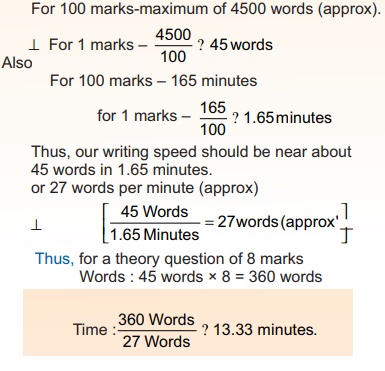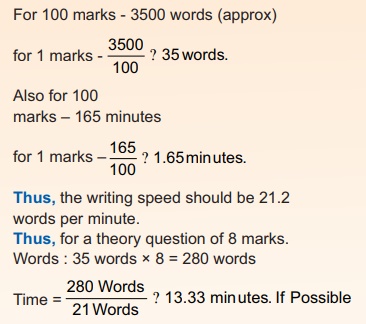Time Management Techniques
Hey,
It's crucial for you to manage your time efficiently because time once gone is
gone forever. We all have a 24 hour a day. What makes a difference is how
well we use it. Let's learn how to manage our time effectively and efficiently
with Time Management Technique (TMT).
- As per the comprehensive study schedule or time table.
- Before use, first develop it.
- Divide total months available into months for completing the course and revising the course.
- Then, divide the entire syllabus in the months available for completing the course.
- This way you get the number of days for finishing a chapter.
- After that prepare a monthly time table followed by daily time table. Applicable to all the subjects.
-
A time table:
- Gives us concrete idea of what to study when
- Saves our time.
- Helps in prevention of leaving the things on mood or chance.
- Makes us efficient and competent to do the scheduled assignment within the stipulated time
- Removes the tendency of postponement, on our part.
- Time table must be realistic taking into consideration our interest, availability of time, ability and moral pressures.
- Be thorough with the content of your syllabus and fix priority of chapters/topics to be studied.
- Fix the priority by analysing past years examination papers.
-
Weightage of a topic is determined on the basis of:
- Being repetitively asked.
- Weightage of marks of the questions asked.
- Make the rank table.
| Chapter in | Chapters | Total marks asked last 20 exams. | Repeatedly Asked Questions | Rank |
|---|---|---|---|---|
| |
|
|
|
|
- Although the syllabus seems vast, the scope of the syllabus is restricted to the various laws, common authenticated and well established rules and regulation and their application.
- Be it accounts, economics, audit, law cost accounts, direct tax or indirect tax etc. Law/rule/regulation cannot be changed by any author.The difference which is apparent is the presentation, explanation and examples used. So we should be very careful while selecting our source and should stick to it.
The Theory Subject
- Make maps of topics/chapters in your mind and also on paper to interconnect your entire syllabus to understand the big picture
- Use Pneumonic Code assets to help you remember things for long.
- Make your own notes.
- Make and use cards that bears topic on one face and its points to remember on the other face. It helps you do a quick revision.
The Practical Subject:
- First grasp the concept of the topics along with the method and formula used.
- Make a summary notes on it, regarding related laws, rules, formulae or techniques used. During revision this will be a handy tool instead of Rank Table Chapter Chapters Total marks asked Repeatedly Asked Rank in last 20 exams. Questions struggling with the book
- In each chapter there are about 30-40 problems. We should we solve all the questions. Different questions are based on different specific problem areas which needs a particular techniques to solve. Underline these specific problem areas with notes so that during subsequent revision we pay attention to those areas.
- Categorise questions that belongs to same problem area. This way the 30 - 40 questions will be reduced to groups of 8-10 or 10-12 (as the case may be).
- This makes us solve the questions speedily as and skip similar problem already solved.
Retain and Remember
- Do not waste time on common problems but concentrate on specific problem areas in every question.
- Develop the habit of revising the whole syllabus at specific intervals.
- Revision is necessary.
First Revision : within 24 hours
Second Revision : Exactly after 7 days of first learning
Third Revision : Exactly after 15 days of first learning - Revision efforts gradually decreases with subsequent revisions.

- Do not study only one subject throughout the day. The general approach is to start and finish one subject and then start other subject. This way you forget the subjects very quickly and easily.
- Study 3-4 subjects everyday.
- Follow Mix-n-Match technique.
Mix-n-Match technique:
- Some chapters are big and some small in every subject.
- Mark the chapter as "B" if they are big and "S" if they are small. Do this for every subject.
- Now mix and match the chapters of one subject with the other that makes it easier to study and also at the same time feel less burdened.
- In addition, match one practical subject with two theory subjects.
- The time allotted to answer each paper in the examination hall is 3 hours out of this 3 hours the effective time is 2 hours 45 minutes i.e. 165 minutes.
- The maximum marks is 100:
- Research suggests that a student can write 4000-5000 words in English and 3000-4000 words in Hindi at a stretch in 2½ to 3 hours
English

Hindi

- Present your answer in a clear and attractive way. Use tables flow diagrams etc.
- Always give precise and relevant answer to the question.
- No need to write introduction/conclusion for direct theory question.
- Length of the answer should commemorate with the weightage of the marks (already discussed) and manage the time in such a way which ensure that you spend at least 5-7 minutes at the end for reviewing purpose.
- Don't use red ink or any sketch pen for underlining the heading or important points. Use black pen/pencils for underlining.
- Don't strike off any answer even if it is 100% wrong especially when you have no other opportunity due to time constraint. It may happen that you may get step marks for parts of the wrong answer.
The various schedules to be followed are:
- Rank table
- Time manager
- Budgeted time schedule
- Firstly analyse the GRAPH and QUICK LOOK and assign weightage accordingly.
- Then on the basis of weightage of the chapter ranks make RANK TABLE. Next use the TIME MANAGER.
Rank Table:
The chapters of the entire subject is ranked on the basis of various factors such as:- Total marks asked in last 20 exams.
- Repeatedly asked question.
- Frequency of question in last 20 exams
Time Manager:
It acts as a booster and inspires a student to complete the first learning or subsequent revision within the stipulated time.| Time Manager | Plans and Manage your Time | |||||||
| Time | First in-depth learning |
Instant Revision (in hours) |
Periodic Revision (in hours) |
|||||
| i.e. ...... .......... Day 1 |
Next Day i.e. .......... Day 2 |
After 7 Days on i.e. .......... Day 8 |
After 30 Days on i.e. .......... Day 30 |
After 60 Days on i.e. .......... Day 60 |
After 90 Days on i.e. .......... Day 90 |
Fix as per your need |
||
| 1. Budgeted | ||||||||
| 2. Actual | ||||||||
| 3. Variance (1-2) | ||||||||
Note :
- Budgeted hours has been fixed on the basis of survey amongst the students, however you may fix it according to your capacity and ability.
- Write the actual time taken by you.
- Variance may be favourable or unfavourable
- if favourable it is a positive sign.
- if unfavourable then you try to recoup it in subsequent learning.
Overcome Procrastination
Procrastinating is putting things off or delaying. Procrastination is the thief of time. It waste time. All the schedules and planners will fail if we procrastinate. Once we have defined are goals and set deadlines for achieving it we should stick to it. We should never wait for the right mood but start right away. No matter what causes the do it later urge- we should overcome the urge with a do-it-now action.